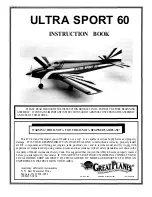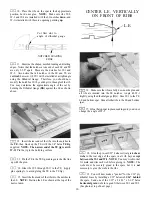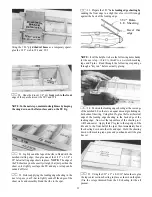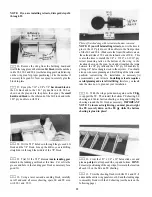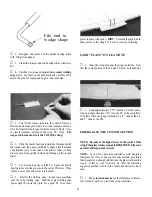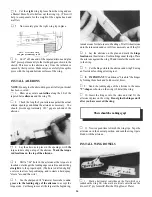
DECISIONS YOU MUST MAKE NOW
ENGINE AND MOUNT SELECTION
The recommended engine size range is as follows:
.60 - .65 cubic inch displacement 2-cycle
.70 - .91 cubic inch displacement 4-cycle
The engine you select will determine how you build the
fuselage, so it is important that you have the engine close at
hand while building.
This kit includes the new Great Planes Adjustable
Engine mount. This mount will work on most .40-.60
2-Cycles and .40-.70 4-cycles. Cut or break the
"spreader bar" off each mount half. The surfaces
where the spreader bars were attached need to be
very smooth to allow the mount halves to fit together.
Snap the two mount halves together. Slide the mount
halves apart until the engine mounting lugs will sit
flat on the beams.
NOTE: If you choose to power your Ultra Sport 60 with a 4.
cycle engine, keep in mind that the RPM of your engine will
be considerably less than that of a 2-cycle engine; therefore,
you should select a higher pitch propeller to keep the speed
and overall performance roughly equivalent to that of a 2-
cycle engine. For example, an 11x7 or 11x8 prop would be
used with a .61 (2-cycle) engine; but an 11x11 prop may be
the best choice for a .91 4-cycle engine.
LANDING GEAR CONFIGURATION
The Ultra Sport 60 may be built with a "taildragger"
or "tricycle" landing gear configuration, and a retractable
main gear may be installed if you want to really ' 'clean up"
this airplane for ultra-smooth and precise aerobatics.
There is not. however, room for a nose gear retract;
therefore, if you want retracts, you'll have to use the "tail-
dragger" configuration.
OTHER ITEMS REQUIRED
• Four-channel radio with 4 servos (additional channel and
retract servo required if retracts are being used).
• Propellers (see engine instructions and above engine
notes for recommended sizes).
• Spinner (2-3/4" diameter)
• Fuel Tank (11 to 14 ounce)
• Main Wheels* - 2 (2-1/2" dia. for fixed gear and retract)
• Nose Wheel* - 1 (2-1/2" diameter, required for trike
only)
• Tail Wheel - 1 (1" diameter, required for taildragger
only)
• 5/32" Wheel Collars - 4 or 6
• 3/32" Wheel Collars - 2 (required for taildragger only)
• Iron-on Covering Material
• Silicone Fuel Tubing
• Wing Sealing Tape (or silicone sealer ... see instruc-
tions)
• Latex Foam Rubber Padding (1/4" thick)
• Dubro "E-Z Connectors" (or equivalent) - 2
• Main Gear Retracts: (optional)
Mechanical: Dave Brown 2-Gear Main, or
equivalent
Pneumatic: Robart #605 90-degree mains, or
equivalent (requires #188 air control kit)
• Plastic Pilot (Williams Bros. 2-5/8" scale)
•"Lightweight wheels are recommended.
SUPPLIES AND TOOLS NEEDED
2 oz. Thin CA Adhesive
2 oz. Medium or Thick CA Adhesive
2.5 oz. 30-Minute Epoxy
Hand or Electric Drill
Drill Bits: 1/16". 5/64", 3/32", 7/64", 1/8", 9/64". 5/32",
13/64", 7/32". and 1/4"
Sealing Iron
Heat Gun
Hobby Saw (Xacto Razor Saw)
Xacto Knife, #11 Blades
Pliers
Screw Drivers
T-Pins
Straightedge
Masking Tape
Sandpaper (coarse, medium, fine grit)*
T-Bar Sanding Block, or similar
Waxed Paper
Lightweight Balsa Filler
1/4-20 Tap, Tap Wrench
Vaseline Petroleum Jelly
Isopropyi Rubbing Alcohol (70%)
3M "77" Spray Adhesive (optional)
Dremel Moto Tool or similar (optional)
*NOTE: On our workbench, we have four 11" T-Bar
sanders, equipped with #50, #80, #100 and #150-grit sandpa-
per. This setup is all that is required for almost any sanding
task. We also keep some #320-grit wet-or-dry sandpaper
handy for finish sanding before covering.
4

